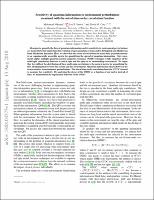Please use this identifier to cite or link to this item:
https://hdl.handle.net/20.500.12202/4290Full metadata record
| DC Field | Value | Language |
|---|---|---|
| dc.contributor.author | Niknam, Mohamad | - |
| dc.contributor.author | Santos, Lea F. | - |
| dc.contributor.author | Cory, David G. | - |
| dc.date.accessioned | 2018-12-31T19:01:08Z | - |
| dc.date.available | 2018-12-31T19:01:08Z | - |
| dc.date.issued | 2018-08-13 | - |
| dc.identifier.citation | Niknam, M., Santos, L.F., and Cory, D.G. (2018). Sensitivity of quantum information to environment perturbations measured with the out-of-time-order correlation function. preprint arXiv: 1808.04375. | en_US |
| dc.identifier.issn | 2331-8422 | - |
| dc.identifier.uri | https://arxiv.org/pdf/1808.04375.pdf | en_US |
| dc.identifier.uri | https://hdl.handle.net/20.500.12202/4290 | - |
| dc.description.abstract | Measures to quantify the flow of quantum information and its sensitivity to environment perturbations are needed to better understand the evolution of open quantum systems and to distinguish non-Markovian from Markovian dynamics. Here, we show that the extent of correlations in many-body quantum systems is an experimentally accessible metric for quantifying the spread of quantum information. Our experiment applies multiple-quantum nuclear magnetic resonance (NMR) technique to take snapshots of the multi-spin correlations between a central spin and the spins in its surrounding environment. We argue that the width of the distribution of these multi-spin correlations is the natural metric for quantifying the flow of information between the system and the environment. Quantum information shared between the two is sensitive to environment perturbations. The out-of-time-order correlation function (OTOC) is used to measure this sensitivity. By analyzing the decay of the OTOC as a function of our metric instead of time, we demonstrate the exponential behavior of the OTOC. | en_US |
| dc.description.sponsorship | Acknowledgments: The research results communicated here would not be possible without the significant contributions of the Canada First Research Excellence Fund, Canada Excellence Research Chairs program, Canada Foundation for Innovation, the Ontario Ministry of Research & Innovation, Industry Canada and Mike & Ophelia Lazaridis. Their support is gratefully acknowledged. L.F.S. was supported by the American NSF grant No. DMR-1603418. | en_US |
| dc.language.iso | en_US | en_US |
| dc.publisher | arXiv.org | en_US |
| dc.relation.ispartofseries | arXiv; | - |
| dc.rights | Attribution-NonCommercial-NoDerivs 3.0 United States | * |
| dc.rights.uri | http://creativecommons.org/licenses/by-nc-nd/3.0/us/ | * |
| dc.subject | quantum information | en_US |
| dc.subject | environment perturbations | en_US |
| dc.subject | nuclear magnetic resonance (NMR) | en_US |
| dc.subject | out-of-time-order correlation function (OTOC | en_US |
| dc.subject | Markovian dynamics | en_US |
| dc.title | Sensitivity of quantum information to environment perturbations measured with the out-of-time-order correlation function. | en_US |
| dc.type | Article | en_US |
| dc.contributor.orcid | 0000-0001-9400-2709 | |
| local.yu.facultypage | https://www.yu.edu/faculty/pages/santos-lea | |
| Appears in Collections: | Stern College for Women -- Faculty Publications | |
Files in This Item:
| File | Description | Size | Format | |
|---|---|---|---|---|
| Santos arxiv Sensitivity1808.04375_3.pdf | arxiv preprint | 2.14 MB | Adobe PDF |  View/Open |
This item is licensed under a Creative Commons License

